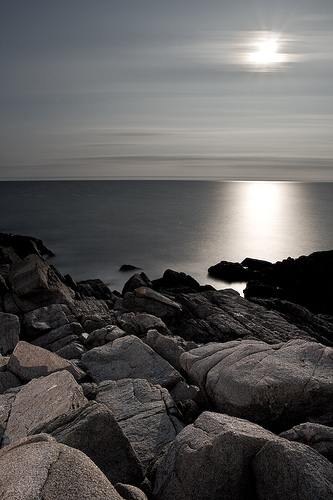Mirror Lockup or, "Why are my tripod photos blurry?"
Have you run into this situation before? You and your tripod get up at 4am to capture that perfect long exposure ocean sunrise shot, only to find that when you get home the shots are all fuzzy? I have and it usually goes something like this…
 You get to the site, set up your tripod, and plug in your remote shutter release. You want to get that creamy effect on the incoming surf, so you choose a long exposure (30 seconds), low ISO (100), and high f-stop (f/11) for maximum depth of field. After framing the shot so you have those nicely textured rocks in the foreground with the ocean and sky taking up the backdrop you fire off some test shots, which of course look brilliant on the 1.5″ x 2″ LCD screen on the back of your camera. You spend an hour taking the exact same perfectly framed shot waiting for the awesome sunrise light to peak and finally capture just the right moment. Ecstatic and reveling in your photographic magnificence, you pack up your gear and head home for a much needed 6am nap.
You get to the site, set up your tripod, and plug in your remote shutter release. You want to get that creamy effect on the incoming surf, so you choose a long exposure (30 seconds), low ISO (100), and high f-stop (f/11) for maximum depth of field. After framing the shot so you have those nicely textured rocks in the foreground with the ocean and sky taking up the backdrop you fire off some test shots, which of course look brilliant on the 1.5″ x 2″ LCD screen on the back of your camera. You spend an hour taking the exact same perfectly framed shot waiting for the awesome sunrise light to peak and finally capture just the right moment. Ecstatic and reveling in your photographic magnificence, you pack up your gear and head home for a much needed 6am nap.
But, when you get home you can’t sleep because you just have to see awesomeness of the shots you just took. You plug in your card reader and start downloading that full 8GB card…
… 3 hours later …
Your images are all downloaded, and you start going through them. They are all soft – almost out of focus, but not quite. Now that feeling you had a few hours ago while packing up your gear is replaced by despair and frustration. “But, I used a tripod!!!”
What you should have done is used that feature hidden in the “Custom Functions” menu that you briefly read about in your camera manual: Mirror Lockup.
With a SLR camera, the mirror that allows you to use the viewfinder has to pop up to get out of the way of the sensor every time you fire the shutter. That’s why the viewfinder briefly goes black during every shot. The motor driving the mirror has to work at ridiculous speeds so is pretty powerful – at least powerful enough to cause a little bit of vibration in the camera that is sufficient to add some hideous motion blur into your photograph.
When mirror lockup mode is enabled, you will have to press the shutter twice for every shot. The first shutter press flips the mirror up (and thus, blacks out the viewfinder). The second press will take the shot and return the mirror to the down position. This prevents the shutter from shaking the camera while it’s sitting on the tripod. Voila – sharper images. The reality is, you only really need to utilize this feature when you start getting to shutter speeds down below 1/15″, but if your brain is thinking “long exposure,” you should go and navigate that maze of custom functions and enable mirror lockup.
After doing this, I think you’ll find the story changes to something more like this…
You get home and download your pictures and they are almost as awesome as you thought they would be. The next day, you go to take a picture of your kid running around in the yard, switch to your 70-200mm lens, set the camera in shutter priority mode to freeze the action, and fire a shot. “CRAP….what happened, everything went black!”
You forgot to turn OFF mirror lockup. I do this almost every time and I doubt I’ll ever learn.